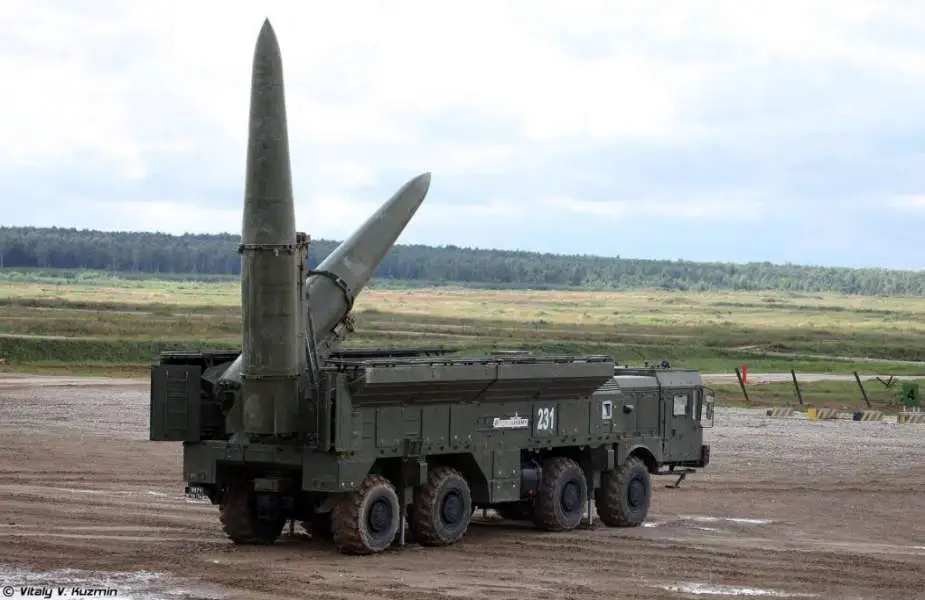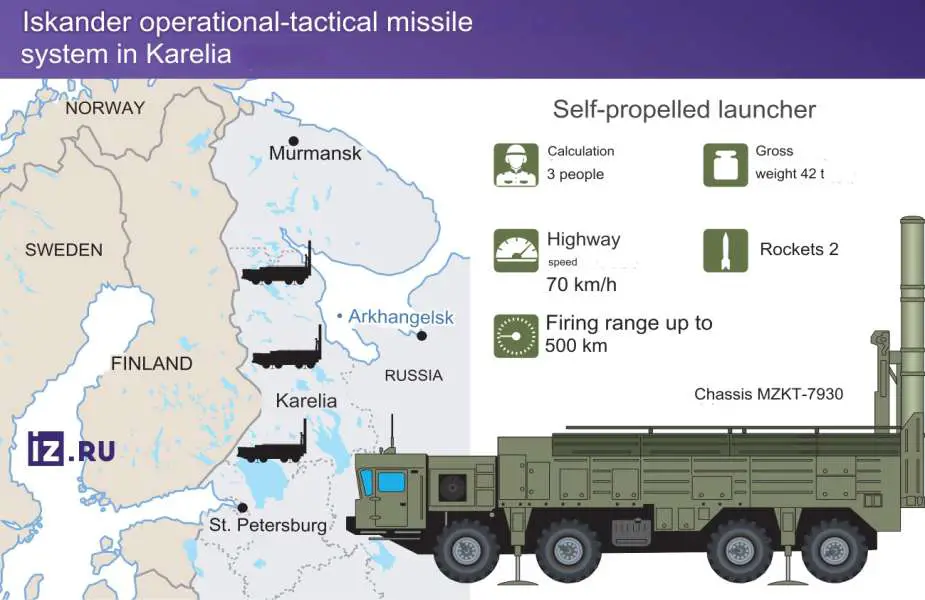Breaking news
Russia deploys Iskander-M Missile Systems in Newly Formed Kaliningrad Military District Facing Finland.
According to the Russian newspaper Izvestia on April 19, 2024, Russian Defense Minister Sergei Shoigu announced the reinforcement of the newly formed Kaliningrad Military District by introducing new formations. A separate missile brigade equipped with Iskander-M systems has been established in Karelia. Additionally, the 11th Army Corps from the Kaliningrad region and the 14th Army Corps from the Murmansk region have been transferred to the district. Experts interpret these developments as a strategic response to Finland's NATO membership to strengthen Russia's northwest borders.
Follow Army Recognition on Google News at this link

Russia Iskander-M air defense system (Picture source: Vitaly Kuzmin)
This development occurs in a context of heightened tensions involving Russia, Belarus, and NATO members, including Finland and Poland. In response to Finland's formal entry into NATO, Russia had previously announced that it had supplied Iskander-M missile systems to Belarus, as the Army Recognition editorial team reported on April 11, 2023. This move is indeed a strategic global effort by Russia to enhance its air defense capabilities along its western border in response to NATO's strengthening presence.
The Kaliningrad Military District is a division of the armed forces of the Russian Federation. In 2010, it merged with the Moscow Military District, the Northern Fleet, and the Baltic Fleet to form the new Western Military District. In December 2022, Defense Minister Sergei Shoigu proposed its reinstatement along with the Moscow Military District, a decision that was confirmed in June 2023 by Deputy Chief of Staff Eugene Bourdinsky. On December 17, 2023, Vladimir Putin announced his intention to re-establish the Kaliningrad Military District in response to Finland joining NATO. The district was formally reconstituted on February 26, 2024, by a presidential decree.
The "Iskander" tactical missile system deployed in Karelia is a key component of this military reinforcement. This system, also used in other regions such as Murmansk and Arkhangelsk, includes a self-propelled launching unit that can travel at speeds of up to 70 km/h on roads. It is equipped with an MZKT-7930 chassis and can carry two missiles. The firing range of these missiles can reach up to 500 km, and the entire system has a total mass of 42 tons. The operational team for each launching unit consists of three people, allowing for quick and efficient mobilization in various operational scenarios.
The 9K720 Iskander (NATO reporting name: SS-26 Stone) is a mobile short-range ballistic missile system produced and deployed by the Russian military. It achieves terminal hypersonic speeds of 2,100–2,600 m/s (Mach 6–7) and can reach altitudes of 50 km, covering distances of up to 500 km. This missile system was developed to replace the OTR-21 Tochka systems in the Russian military.
An Iskander-M battery includes a variety of vehicles necessary for the battery's operation, including 4 TELs 9P78-1 (Transporter Erector Launchers), 4 loaders 9T250-1, and 2 command and control vehicles 9C552.
The Iskander can be equipped with various conventional warheads, including cluster munitions, fuel-air explosive enhanced-blast warheads, high-explosive fragmentation warheads, earth penetrators for bunker penetration, electromagnetic pulse devices for anti-radar missions, and nuclear warheads. As of September 2017, it was reported that Iskander has access to at least seven missile types, including cruise missiles.
The Iskander-M system employs two solid-propellant single-stage guided missiles, model 9M723K1. These missiles are fully controlled throughout their flight paths and are equipped with inseparable warheads. The mobility of the launch platform makes interception difficult.
Targets can be identified through satellite imagery, aircraft, conventional intelligence centers, artillery observers, or scanned aerial photographs. Missiles can be retargeted during flight to engage moving targets. A distinctive feature of Iskander-M is its optically guided warhead, which can also be controlled via encrypted radio transmission, including from AWACS or UAVs. The missile's onboard computer receives target images, locks onto the target using its sight, and descends toward it at supersonic speed.
The missile's thrust vector control (TVC) during the boost phase is achieved using graphite vanes, following a layout similar to V-2 and Scud series tactical ballistic missiles. There are speculations that the missile follows a quasi-ballistic trajectory, executes evasive maneuvers in the terminal flight phase, and deploys decoys to penetrate missile defense systems. The missile remains within the atmosphere, maintaining a relatively flat trajectory while being controlled throughout the flight using gas-dynamic and aerodynamic control surfaces, including small fins designed to minimize radar detection.
The Russian Iskander-M travels at a hypersonic speed of 2100–2600 m/s (Mach 6–7) and reaches an altitude of 50 km. With a weight of 4,615 kg, it carries a warhead weighing between 710–800 kg, boasting a range of 500 km. The missile demonstrates a circular error probable (CEP) of 5–7 meters when utilizing an optical homing head, and 30–70 meters in autonomous applications.
The Iskander is designed as a tactical missile system for use in conflicts at the theater level. It can employ conventional or thermonuclear warheads to engage both small and large targets, including hostile artillery, air and anti-missile defenses, command centers, communication nodes, and concentrations of troops, among other objectives. The missile's area of effect from a single warhead is said to cover 25,000 square meters, and its precision enables it to strike targets as small as a small window from considerable distances, ranging in the tens of kilometers.
In 2007, a new missile for the system, the R-500 cruise missile, was tested, boasting a range of up to 2,000 km or more. In cases of nuclear armament, the warhead's yield is estimated to range from 5 to 50 kilotonnes of TNT (21 to 209 TJ).

Russia Iskander-M air defense system deployed in Karelia/Kaliningrad district (Picture source : IZ.RU)























